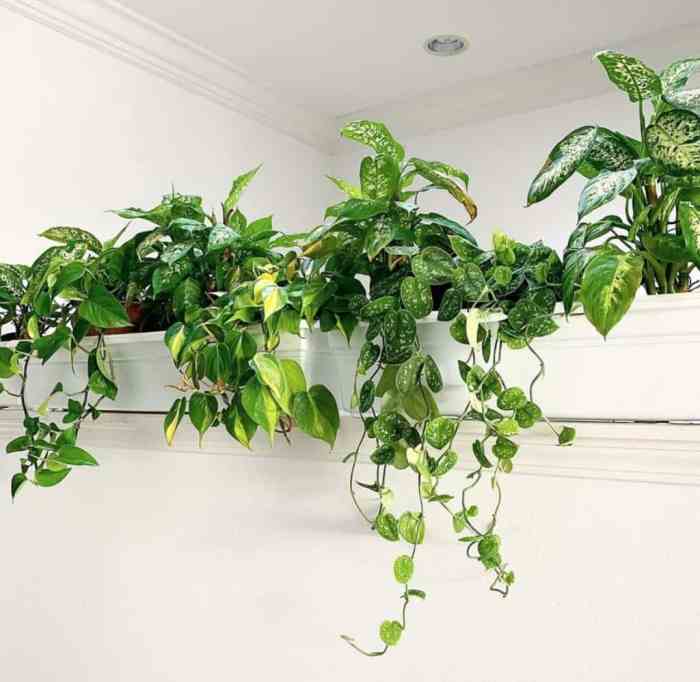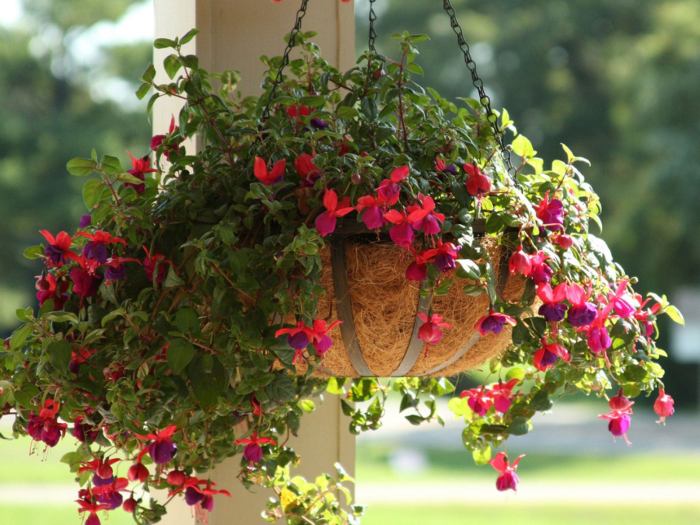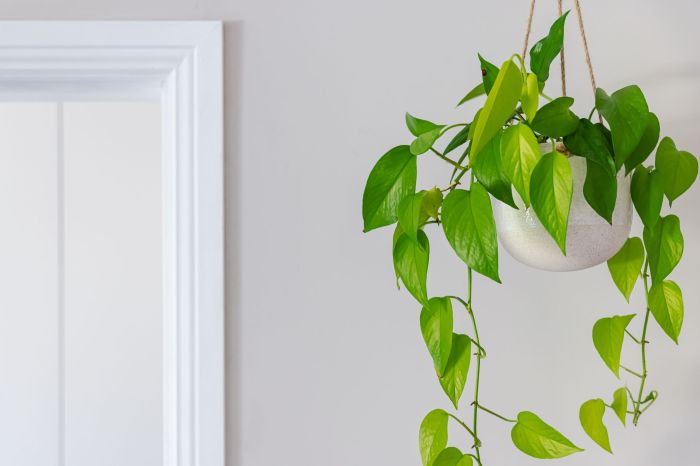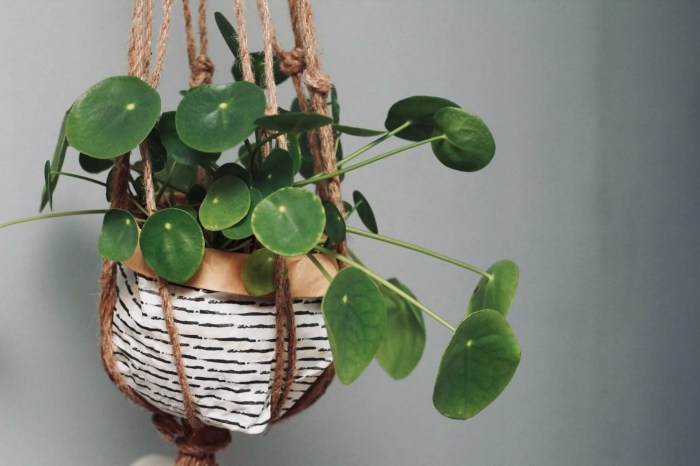Best hanging plants for shade indoors – In the realm of indoor gardening, hanging plants for shade interiors emerge as a captivating solution, offering a verdant touch to spaces deprived of ample natural light. These botanical wonders not only enhance aesthetics but also contribute to a healthier indoor environment.
Our comprehensive guide explores the diverse range of hanging plants that thrive in low-light conditions, empowering you to create a vibrant oasis within your shaded indoor spaces.
Types of Hanging Plants Suitable for Shade Indoors

Indoor hanging plants are a fantastic way to add greenery and purify the air in your home. However, not all plants can tolerate the low-light conditions found in many indoor spaces. Here is a comprehensive list of popular hanging plants that thrive in shade:
- Botanical Name:Epipremnum aureum Common Name:Pothos Description:Hardy vine with heart-shaped leaves that can tolerate a wide range of light conditions.
- Botanical Name:Philodendron hederaceum Common Name:Heartleaf Philodendron Description:Trailing plant with glossy, heart-shaped leaves that prefer indirect light.
- Botanical Name:Scindapsus pictus Common Name:Silver Pothos Description:Vine with variegated leaves and silver markings that can tolerate low light levels.
- Botanical Name:Chlorophytum comosum Common Name:Spider Plant Description:Produces long, arching leaves with white stripes and trailing plantlets.
- Botanical Name:Peperomia obtusifolia Common Name:Baby Rubber Plant Description:Small, compact plant with thick, rounded leaves that can tolerate low light and infrequent watering.
- Botanical Name:Aspidistra elatior Common Name:Cast Iron Plant Description:Extremely hardy plant with dark green, sword-shaped leaves that can survive in even the darkest corners.
Factors to Consider When Choosing Hanging Plants for Shade

When selecting hanging plants for indoor shade, it is crucial to consider several key factors that influence their growth and well-being. These factors include:
Light Requirements
Understanding the light levels in the room is essential. Choose plants that can tolerate low light conditions, such as ZZ plants, snake plants, or pothos. Consider the direction of the windows and the amount of natural light available throughout the day.
For indoor spaces with limited sunlight, choosing the best hanging plants for shade is crucial. Many varieties thrive in these conditions, offering lush greenery and air-purifying benefits. Some of these shade-tolerant plants also exhibit beautiful trailing growth habits, creating a cascading effect that enhances the ambiance of any room.
Explore a wide range of beautiful trailing indoor plants to find the perfect addition to your shady indoor spaces, adding both beauty and functionality to your home.
Humidity Levels
Humidity plays a vital role in plant growth. Many hanging plants prefer high humidity levels. If the environment is dry, consider misting the plants regularly or using a humidifier. Alternatively, group plants together to create a microclimate with increased humidity.
For those seeking to add a touch of greenery to dimly lit spaces, hanging plants offer a practical solution. Among the best hanging plants for shade indoors are those that thrive in low light conditions. Best hanging indoor plants low light include the Spider Plant, ZZ Plant, and Snake Plant, all of which are known for their adaptability to low-light environments.
These plants not only enhance the aesthetic appeal of indoor spaces but also contribute to air purification, making them ideal for creating a comfortable and inviting atmosphere.
Benefits of Hanging Plants in Indoor Shaded Areas: Best Hanging Plants For Shade Indoors

Incorporating hanging plants into indoor shaded areas offers numerous benefits, enhancing both the environment and the well-being of occupants.
One significant benefit is air purification. Certain plants, such as spider plants, peace lilies, and snake plants, have the ability to absorb and remove toxins from the air, improving indoor air quality. This is particularly beneficial in closed or poorly ventilated spaces, where air pollution can accumulate.
For those seeking to add a touch of greenery to their indoor spaces with limited natural light, selecting the best hanging plants for shade indoors is crucial. To explore a wide range of options, consider Plants , a comprehensive resource dedicated to all things plants.
Whether you prefer trailing vines or cascading foliage, their experts have curated a selection of plants that thrive in low-light conditions, ensuring you can create a lush and inviting indoor oasis.
Stress Reduction
Studies have shown that the presence of plants in indoor environments can reduce stress levels and promote relaxation. Interacting with plants, such as watering or simply observing their greenery, has been found to have a calming effect. Plants create a sense of tranquility and can help reduce anxiety and improve overall mood.
If you’re looking for the best hanging plants for shade indoors, you’ll want to consider plants that are tolerant of low light conditions. Some of the best choices include pothos, snake plants, and ZZ plants. These plants are all relatively easy to care for, making them a great option for beginners.
For more tips on choosing the best hanging plants for your home, check out our guide to best easy hanging plants . We’ll help you find the perfect plants to add a touch of greenery to your home, even if you don’t have a lot of natural light.
Care and Maintenance Tips for Hanging Plants in Shade

Maintaining the health and beauty of hanging plants in indoor shaded areas requires specific care and maintenance practices. Regular watering, fertilizing, pruning, and pest control are crucial for their well-being. This guide provides detailed tips to help you nurture your hanging plants and keep them thriving in low-light conditions.
paragraphTo ensure the optimal growth and appearance of your hanging plants, it’s essential to address their unique needs in shaded environments. Watering, fertilizing, and pruning should be adjusted to suit the lower light levels, while pest control measures become even more important to prevent infestations in these conditions.
Watering
Regular watering is crucial for the survival of hanging plants in shade. During the growing season, water the plants thoroughly when the soil feels dry to the touch. Avoid overwatering, as this can lead to root rot. Reduce watering frequency during the dormant season, allowing the soil to dry out slightly between waterings.
Fertilizing
Fertilizing hanging plants in shade is beneficial for promoting growth and maintaining health. Use a balanced liquid fertilizer diluted to half strength and apply it monthly during the growing season. Avoid over-fertilizing, as this can burn the roots and damage the plant.
Creative Display Ideas for Hanging Plants in Shade

Incorporating hanging plants into indoor shaded areas offers a creative and refreshing touch. These plants bring life and greenery to dimly lit spaces, creating a sense of tranquility and freshness. There are various ways to display hanging plants in shade, each adding a unique aesthetic appeal.
Macrame Hangers
Macrame hangers are a popular choice for displaying hanging plants in style. These hangers, made from knotted cords, come in a variety of designs and patterns. They add a touch of bohemian flair to any room and allow you to adjust the length of the plant’s suspension, making it easy to find the perfect placement.
Ceiling Hooks
Ceiling hooks are a simple yet effective way to hang plants from the ceiling. They come in different sizes and styles, allowing you to choose the right hook for the size and weight of your plant. Ceiling hooks can be used to create a cascading effect by hanging multiple plants at varying heights or to suspend a single plant as a focal point.
Vertical Gardens
Hanging plants can be used to create vertical gardens, adding a touch of greenery to walls or other vertical surfaces. This is a great way to maximize space in small rooms or to create a living wall in larger spaces.
Vertical gardens can be created using hanging planters, trellises, or other structures that allow plants to climb and grow vertically.
Space Dividers, Best hanging plants for shade indoors
Hanging plants can also be used as space dividers, creating a sense of privacy or separation in open-plan spaces. Larger hanging plants, such as ferns or trailing ivy, can be suspended from the ceiling or hung on walls to divide a room into different sections.
This is a creative way to add greenery and functionality to a space.
Wrap-Up
Embracing hanging plants for shade indoors unlocks a world of possibilities, transforming dim corners into lush havens. Their ability to purify the air, reduce stress, and elevate the ambiance makes them invaluable additions to any home or office space. With proper care and maintenance, these botanical companions will flourish, bringing a touch of nature’s beauty to your indoor sanctuary.
Answers to Common Questions
Which hanging plants are best suited for low-light conditions?
Pothos, heartleaf philodendron, and ZZ plant are excellent choices for hanging plants that can tolerate low light levels.
How often should I water hanging plants in shade?
Water hanging plants when the soil feels slightly dry to the touch, usually once or twice a week.
Can hanging plants help improve air quality?
Yes, certain hanging plants like spider plants and peace lilies have air-purifying properties, removing toxins from the air.